c1880
George Morefield purchased a 198-acre tract of land in Amelia County, Virginia (Jones 1940). At some point before 1929, this land became the property of his son, Silas Morefield.
January 27, 1883
William Morris Fontaine wrote his “Notes on the occurrence of certain minerals in Amelia County, Virginia” in the American Journal of Science. He notes that the Native Americans, or “Indians,” had worked the Amelia pegmatites in years previous.
“Notes” was Fontaine’s first-hand account; he indicated that he had been to Amelia County several times. He notes that “amazon stone,” in considerable volumes, had been mined from Rutherford #2, just four miles away from what would later be Morefield mine. “It ranges in color from bluish-green to verdigris green. The mode of occurrence of this feldspar strongly suggests the idea that the color comes from solutions infiltrating into the deposit from the surface, and making their way through the crevices of the vein. The green color most commonly is deepest in the portions of a mass of spar next to a fissure, or line of dislocation, and fades gradually until it is entirely lost in the mass of the material. Hence, often, hand specimens will be only partly colored (Fontaine, 1883, p. 332).
November 6, 1893
Silas Varner Morefield was born, in Amelia County, Virginia.
1912 to 1932
Penick (1993) notes that Amelia County’s Rutherford Mine #1 was being mined for Feldspar var. Amazonite (sic; this is now officially called Microcline var. Amazonite; hereafter in this work, it is referred to as “amazonite”). American Gem and Pearl Company of New York City was responsible for mining about 15 tons of Amazonite, worth about $60,000 at that time (Sinkankas 1959)—which, at press time for this book, would be valued at over $1.1 million dollars.
1922
Warren "Bill" Baltzley was born. He grew up in Fairfield, Pennsylvania, a tiny borough 8 miles southwest of Gettysburg (Schabilion 2009).
1928
A. A. Pegau’s survey indicated that, while there were a plethora of dikes in Amelia Court House, Virginia, only the two at Rutherford Mines featured rare minerals. At Rutherford Mines, 33 varieties of minerals had been found; at all of the others, only a half-dozen species had been found (Pegau, 1928, p. 583).
September 1929
“The story [of the origins of Morefield mine], as written by Mr. Silas Morefield in Lapidary Journal, says he was hunting on his land in September 1929 when he came across an outcrop of quartz with a large beryl crystal exposed. He was very familiar with the minerals of the older Rutherford Mine and Champion Mine, also in Amelia County, and he suspected that this outcrop may be a pegmatite. At some point, he drilled a hole in the outcrop, loaded the hole with dynamite, and shot it. He exposed large masses of mica and weathered amazonite.
1929-1931
“Mr. Morefield operated the mine by open cut methods from 1929 until 1931” (History 2017).
November 1931
At some point shortly before this date, a 50-foot shaft had been sunk on Morefield mine (Pegau 1932).
1930 to 1931
Pelau (1932) noted that a large production of amazonite and beryl had occurred at Morefield during these years. Additionally, some gem materials had been reported, though those had been used exclusively for museum specimens. He also presciently suggested, “It is probable that further work will reveal other gem minerals” (p. 11). Silas Morefield had reported 3 carloads of amazonite and 2.5 tons of beryl being produced (p. 60).
1931-1934
“[In] 1931 [Morefield mine] was leased by the Seaboard Feldspar Corp. of Baltimore, Maryland, and mined for amazonite, beryl, mica and tantalite for about 3 years” (History 2017).
1932
Arthur A. Pegau authored Pegmatite Deposits of Virginia, which features Morefield mine. His mention of topaz at Morefield mine appears to be the first in print, reporting 1 mm. colorless grains.
1933
Besides telling his story to Rocks & Minerals magazine, Morefield specifically invited readers of the magazine to visit his mine. He indicated (1933), “I will do my best to make their visit interesting. I can be easily be located at Amelia Court House, Virginia, as we are the only Morefield’s in this County.” By this point, Morefield and Seaboard had created an open cut mine, 10-15 feet in depth along 200 feet of the dike (Glass 1935).
1934-1940
Silas Morefield operated the mine intermittently (Sweet and Penick 1986).
1935
Jewell J. Glass authored the first scholarly work about Morefield mine, calling outs its attractive deposits of zinnwaldite, triplite, phenakite, and topaz crystals.
1939
The War Production Board was created. “The War Production Board (WPB) was an agency of the United States government that supervised war production during World War II. President Franklin D. Roosevelt established it in August 1939, with Executive Order 9024.” Retrieved from
https://en.wikipedia.org/wiki/War_Production_Board - find primary source
1935 to 1945
Mica and beryl were shipped from Morefield mine to support the United States during World War II.
1940
Pat Jones wrote a contemporary piece, including scathing commentary on Hitler’s impacts to Silas Morefield’s amazonite industry. In reference to Morefield’s previously-mentioned offer in Rocks & Minerals magazine, for people to visit his pegmatite, Jones writes the following, “In addition to the money [Morefield] has received from the minerals, it has brought him numerous friends. Geologists have come from all over the world to see his mine with its 37 varieties of minerals. Whether from California or Canada or Belgium, it is all the same. He tucks these visitors under his wing and listens to what they have to say. He sits in the gloaming [twilight or dusk] and talks with them. He reads the literature they leave behind, studies the reference volumes they call to his attention.”
A cautious reader will note the past tense in Jones’ writing—has received, has brought, have come…these verbs suggest that the glory days, the gem-filled days, of the Morefield mine were numbered. Jones (1940) writes, “nature is having a picnic. The building where he stored his tools is decaying. Water stands along the bottom of the mine and the one-time upright walls are sloping in, bit by bit. Winds whistle a dirge to bygone days through the sweep of pines overhead, and rabbits underfoot turn aside to avoid the yawning pit. Only the old pipeline that brought water to wash the stones looks like it still might mean business. The owner doesn't go there often now. And when he does, it's just to look around, to scratch with a spade, or to send his terriers, Jack and Joe, down into the hole for a stick or a stone or an old shoe sole. Maybe one of these days somebody else will start cutting semiprecious stones," he says to himself. And then, I'll start mining again. There's plenty of the stuff here. All I need's the market."
1941
Seaboard Feldspar Company and Southern Minerals, Inc. completed exploratory work (Sweet and Penick 1986).
1942
It took a couple of years, but Morefield found his market. History (2017) notes that he “leased it to Minerals Separation of North America in 1942.” In 1942 Metals Reserve Company took it over (Sweet and Penick 1986). At this point, the mine measured an open trapezoid, 230 feet long and between 8 and 60 feet wide, and 25 feet deep. While there was a shaft, it was caved—understanding how and when that happened would be interesting. There were additional pits, as well, where certain prospects would be explored (Sweet and Penick 1986).
1939 to 1943
From 1939 to early 1943, according to Geehan (1953, p. 1), the Bureau of Mines had been reviewing “deposits of critical and essential minerals,” to support the needs for international war. Trenching and diamond drilling were the next recommended steps, which were accomplished between August and December of 1943, as an experiment. “This company was taken over by the Metals Reserve Company…and they returned the mine to Mr. Morefield in 1943. The Metals Reserve Company was a government agency under the Reconstruction Finance Corp. that was in charge of the National Stockpile of “strategic and critical materials” for the WW II war effort and national mineral security. The critical minerals at the Morefield mine were mica, beryl, and tantalum minerals” (History 2017).
January 1943
Metals Reserve Company returned the mine to Silas Morefield. Between 1943 and 1944, Morefield extended the shaft to the 60 foot level. He also “started drifts along the north wall at about the 45-foot level” (Sweet and Penick, 1986, p. 13). How he acquired the expertise to do this is unclear—did Morefield do the work himself, or did he hire a company to handle the mine shaft project? Either way, this accomplishment is impressive.
August to September 1943
“The U.S. Bureau of Mines first explored the deposit during the summer and fall of 1943 during which time they drilled four diamond drill holes and excavated four trenches crosscutting the pegmatite. Then two more definition diamond drill holes were drilled and an additional trench added” (History 2017). Geehan (1953) notes the specific months for this exploration as August through December of that year (p. 10).
1943 to 1945
Per Geehan (Morefield, 1953), “[d]uring the war years, several attempts were made to work these dikes, but the results were disappointing in terms of pounds of minerals produced, primarily because the ore was spotty. An experimental program designed to test new mining methods and to determine the character of the deeper ores was recommended” (p. 10). In other words, they had to drop back and punt.
1944
Up through this point, since the beginning of the mine, seven (7) tons of beryl had been mined at Morefield (Sweet and Penick, 1986).
1947 to 1949
According to Geehan (1953), the United States Bureau of Mines conducted a testing program from September 1947 to March 1949.”
1948
The U.S. Bureau of Mines returned to the mine and conducted experimental development for several months (Sweet and Penick 1986). Next, they deepened the mine shaft from 60 feet to 115 feet, conducting underground diamond drilling to establish the wall rock/pegmatite contacts, drove a drift 75 feet at the 100 foot level, and extracted a large bulk sample by selectively shooting long drill holes (‘longholes’) in the high grade part of pegmatite. The purpose of this work was to test underground methods of mining pegmatite should mica, beryl and tantalum should they become in critical supply (History 2017). All of this work proved that the Morefield pegmatite has “unusually large dimensions,” being “proved on the surface for 1,000 feet along the strike and vertically to a depth of 200 feet; its inferred dimensions are considerably greater.” The pegmatite shows a downward tapering tendency (Sweet and Penick 1986, p. 13-15).
1949
No one has explored this [100 foot] level since 1949 when the U.S. Bureau of Mines ceased operations.**
Retrieved 4/11/2017, from http://www.morefieldgemmine.com/history.html
1953
R. W. Geehan (Morefield, 1953) finished work on the manuscript of Morefield Pegmatite Mine, Amelia County, Virginia in April 1953. It was subsequently published by the United States Department of the Interior in November 1953. As a 21st-century reader of this report, you may
find one of the most valuable sections of information in this booklet to be the results of the 1953 beneficiation test. The Eastern Experiment Station in College Park, Maryland, crushed the material to a minus-65-mesh, and the results give you a potential mine visitor a clear idea of the proportions of material that might be found during several times a day when the mine tailings are dumped. This assessment of 1300 pounds of pegmatite from the mine indicated that the composition was 75.2% feldspar, 12.1% quartz, 11% mica, 1.6% other minerals, and 0.1% the rare metal(s) “Tantalite-columbite (sic),” [the latter broken out separately because of its high value]. Besides the amazonite portion of the feldspar, it is often the “other minerals” category that interests rock hounds—topaz, beryl, garnet, fluorite, and tourmaline (p. 7). In contrast, micrometer testing at Rutherford mines had indicated a composition of 60% feldspar, 24% quartz, 11% biotite, 3% muscovite, 1% garnet and 1% accessory minerals (Pegau, 1928, p. 583).
While the individual components were quite variant, the combined percentages of feldspar and quartz were relatively similar at the two mines, as were the breakouts of types of mica and other minerals.
In addition to the afore-mentioned test, the following tests were performed: tabling the constituents with a minus-20 mesh; using a Dings-type IR-O magnetic separator; constriction plate classifier; electrostatic separation; flotation tests; chemical analysis of the feldspar concentrate (to assess feasibility of use in the glass industry); screen analysis. In other words, the heft of many of the available resources of the United States government was applied to determine the viability of the Morefield pegmatite (Geehan, Morefield, 1953, p. 8-10). This information has been invaluable as a baseline—for Morefield, for Baltzley, for the Dunaways
and beyond.
The decision the government made with respect to the Morefield pegmatite was to make “an agreement…with the owner permitting the Bureau of Mines to work on his property” (p. 10). This meant drilling and a mining plan.
All told, by 1953, the following had been accomplished: 760 linear feet of surface trenching (divided into 5 trenches), 2 test pits, 148 drilled holes, a shaft sunk, drifting, crosscutting, raising, 3 roads surfaced, and 23 samples taken (p. 11). Interestingly, the headframe of the mine was built of timber cut from trees near the mine; there was an 18’x18’ cross section at the top of the mine. Water was an issue. Surface water was managed by “a drain…in the side of the open-cut".
(p. 12). Since the permanent water level was just 5’ below the shaft collar, a sump was required. Map of the 45- and 100-foot levels of the mine were created, demonstrating the locations of the drilled holes. Those interested in explosives may be interested to know that it required “20.9 pounds of dynamite and 10.1 blasting caps..per foot of advance” (p. 13).
C1956 or 1957
Morefield had a commercial sale of 1,500 pounds of minerals to a woman from Cornell University. The minerals were used to create sets of rocks and minerals (Amelia, 1957, p. 21).
1957
Per Sinkankas (1968), Warren D. Baltzley began managing the Rutherford Mine, operating as Piedmont Mining Company of Amelia, Virginia. The mining, characterized as extensive, included bulldozing the existing opencut workings in Mine #1 to expose the shaft collars, as well as mucking out and dewatering Mine #2 (p. 374). These kinds of mining projects are similar to those Baltzley would need to undertake at Morefield mine nearly 30 years later.
1959
Silas Morefield died on July 28, 1959, aged 65, and was buried at Arbor Baptist Church, which is
very close to Morefield mine.
1960s
Per David Packard (video conversation, 2017), a Mr. Dunn leased the property from Mrs. Morefield. He allowed people to come out and search on certain weekends, for perhaps $1.00.
No date (between 1948 and 1985)
“Deck Boyles of Amelia County bought the property from the Morefield Estate and used the shaft as a water source for serving customers with swimming pools for many years. Retrieved 4/11/2017, from http://www.morefieldgemmine.com/history.html
1962
Sam Dunaway first visited Rutherford mine. He explained, “It was a field. Little bit of feldspar. I wasn’t sure where the opening was” (personal conversation, 3-8-2016).
1980
Sweet and Penick (1986, p. 17) noted that, when the value of tantalite-columbite series minerals hit the $100 mark, there was an assessment of the viability of mining for these rare earth minerals. This involved cutting more shallow trenches to the southwest of the existing mine shaft.
“Foote Mineral Co. took six surface grab samples on November 17, 1980 and reported 0.18
pounds per ton tantalum and 0.90 pounds per ton niobium. The bulk sample taken by the USBM came from a depth of about 75 feet in a large raise and diamond drill station located just southwest of the main shaft. Beneficiation tests were conducted at the Eastern Experiment Station at College Park , Maryland. The tantalite-columbite was determined by grain count and reported to be, “0.1 percent by grain count and equivalent to about 0.2 percent by weight or about 4 pounds per ton”. They found from hand-picked specimens and analysis of the tantalite that the mineral contained 45.7 percent Ta2O5, 31.2 percent Nb2O5, and 2.0 percent Ti02. The
concentrates were obtained from a 1300 pound sample using tables, magnetic and electrostatic separation. It was estimated to contain 43.7 percent Ta2O5. This is a much higher concentrate grade than the 30 percent minimum Ta2O5 content used as the basis for commercial sales. Morefield [M]ine (sic) concentrate would bring a higher price per pound” (History 2017).
June 16, 1981
Miriam Morefield, the owner of Morefield mine, died. She was buried at Arbor Baptist Church, near her husband Silas and their baby.
March 1985
In March 1985, “Powhatan Mining Company, operated by W. D. “Bill” Baltzley, acquired the Morefield pegmatite mine…The operator plans to develop commercial mining for gem and strategic materials as well as to allow collecting for a fee” (Sweet and Penick, 1986, p. 1). __________ sold it to Warren “Bill” Diehl Baltzley in 1985 who developed the mine as a recreational and commercial operation very much as it is seen today. Mr. Baltzley sank the 45-foot deep Baltzley Shaft and extended the stub drifts excavated by the U.S. Bureau of Mines at the 45-foot level and connected the old and new shafts” (History 2017).
The mine’s official address at that point was Powhatan Mining Company, Route 4, Box 310, Amelia, Virginia 23002. Telephone number was 804-561-3399 (Sweet and Penick, 1986, p. 17).
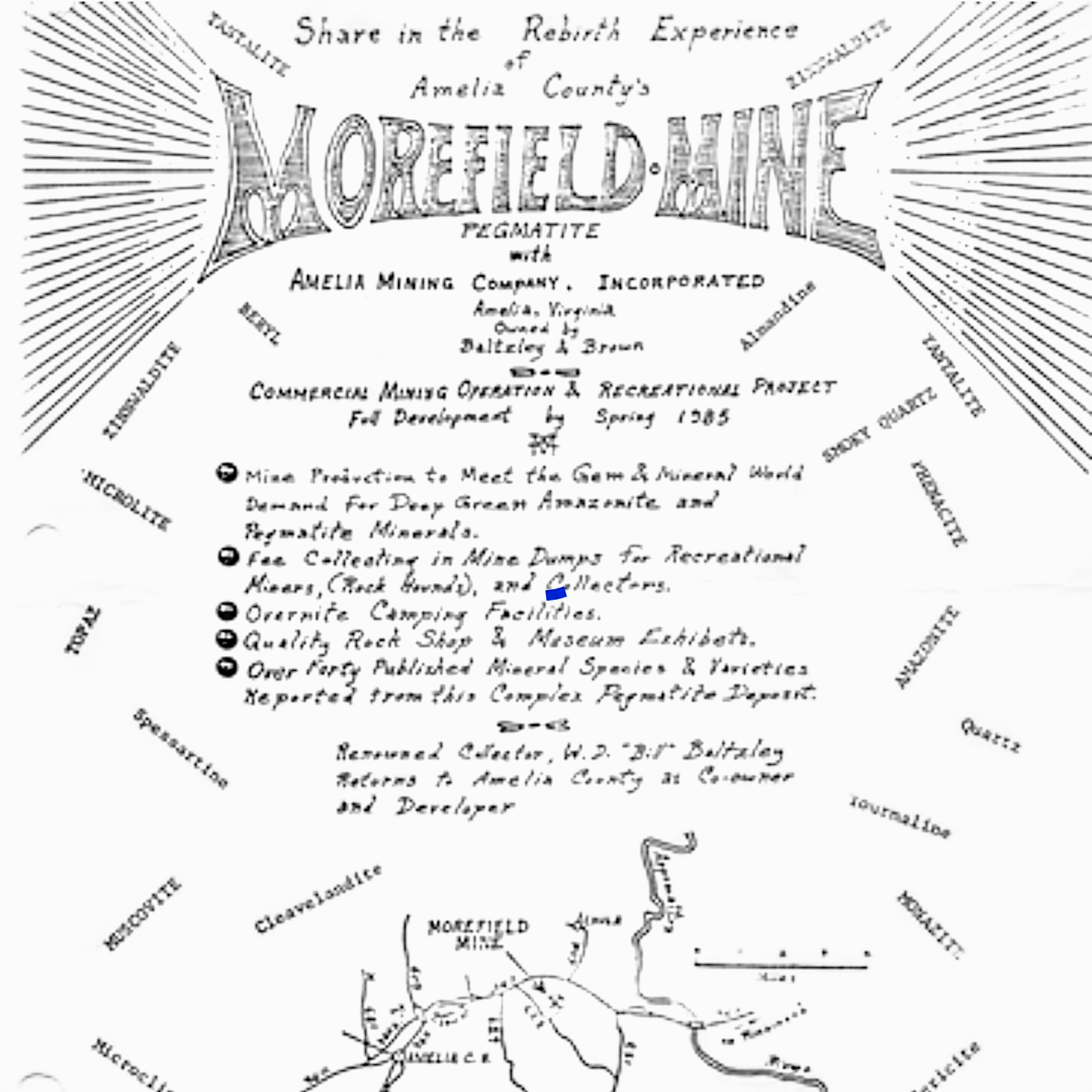 Summer 1985
Summer 1985
Bill Baltzley published this flyer (above). A couple of important points:
- This is the first documentation I have found that indicates that there was a "Brown" that co-owned the property. At this point, he was doing business as Amelia Mining Company, Incorporated.
- This is the first notation we have of people camping on Morefield mine property.
- At this point, he has a rock shop and some museum exhibits. It is unclear why the timing is different on this then it was in the Penick 1986 source, which indicated that the museum and Rock Shop were being built in early 1986.
January 1986
Construction began on the Morefield mine museum and rock shop; a photo by W. D. Baltzley was included in the Sweet and Penick (1986) article.
1986
The collecting fee at Morefield mine started at $5 in 1986, when Baltzley expanded retail operations, and $3 for children. Baltzley’s operations were year-round and included viewing the exhibits, limited digging in veins, searching the material dumped from the mine and cleaning all one’s finds in the sluice box (Sweet and Penick 1986). Camping was possible, as well.
1989
March 1, 1989 found owners Warren and Joan Baltzley leasing 65 acres to Martin Marietta (at time of press, known as Lockheed Martin) for a period of 30 years (with potential subsequent 10-year extensions), for the sum of $1.00, plus other annual considerations. The fixed rental
earned the Baltzley’s $10,000 rent per year until the mining commenced and $30,000 per year thereafter. This allowed Martin Marietta to process and remove any product on the property, with the lessees receiving 4% of anything sold. If, after the first year, they had sold the property to the lessees, the cost would have been $4,000 per acre. Given that the entire plot was 80 acres, the Baltzley’s retained 15 acres for their own purposes, including their dwelling, the mine, the lake and a camping area (State 1989).
1991
“On September 1, 1991, an exceptionally large (2829 carats) spessartine garnet was found at the [Rutherford] mine by Richard Seaver of Cumberland County, Virginia. This gem is currently on display at the Morefield mine museum in Amelia County” (Penick and Sweet, 1992). This is the first reference we have identified that has indicated that there was a completed museum at Morefield mine (construction had begun on the museum in 1986).
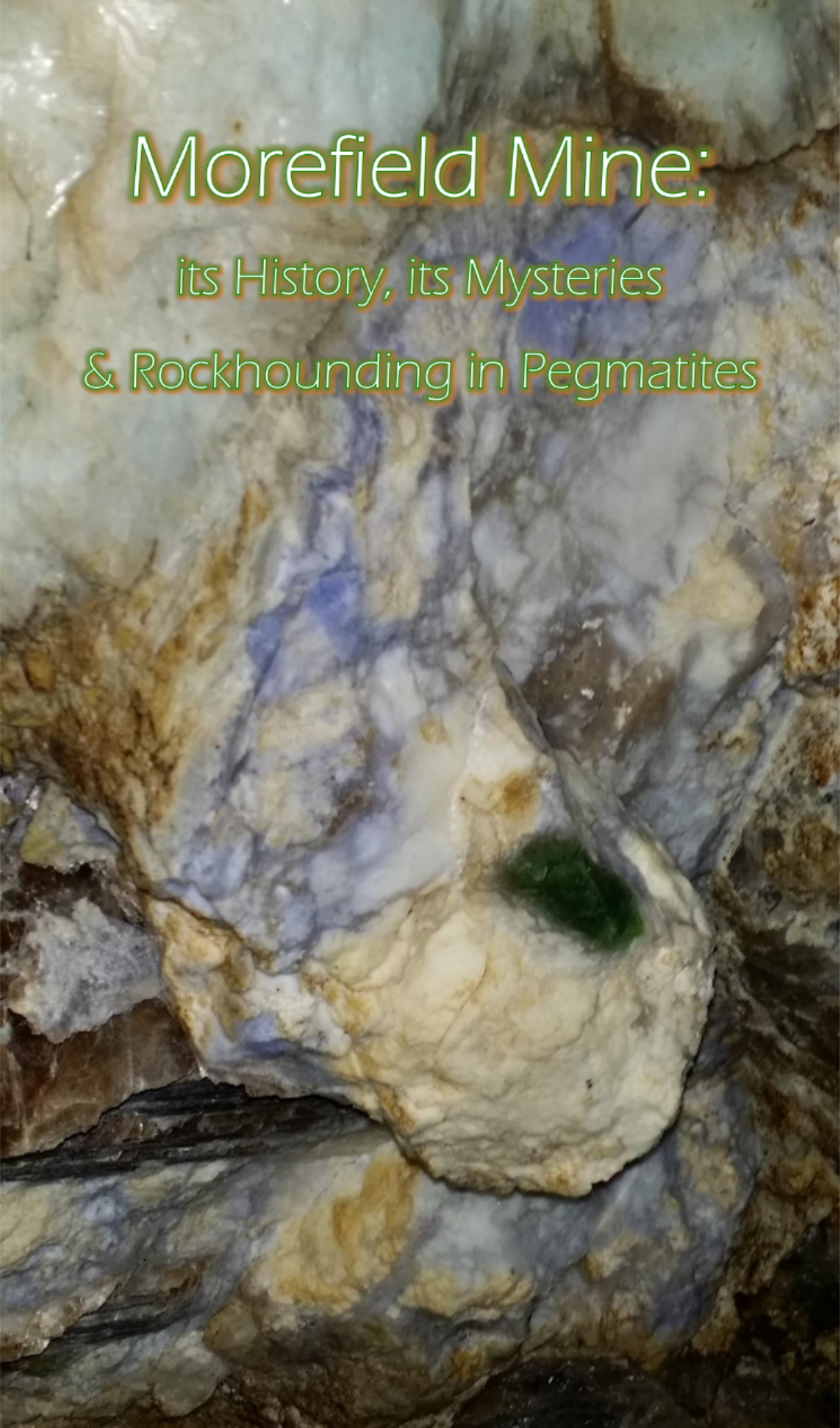 July 1991
July 1991
The first reported occurrence of prosopite in Virginia was discovered by Bill and Joan Baltzley, about 125 feet from the main shaft, in the ceiling of the 45-foot level. The Baltzleys, as Powhatan Mining Company, submitted specimens for analysis to Dr. Lance Kearns, a professor at James Madison University (Kearns, 1992, p. 14).
↩️ Prosopite, lavender mineral in this photo, is stunning in the mine wall.
January 1992
Mr. David Thompson, from Virginia Beach, Virginia, located pyromorphite for the first time at Morefield mine. This is exciting evidence that there are important finds to be made in the dumps, not just in the mining inside the mine (Kearns, 1992, p. 14).
1993
Penick (1993) indicated that “Gem quality amazonite continue to be produced from the Moorefield (sic) mine, which is currently operating as a fee collecting mine.” His article also featured a photo of an amazonite crystal mined from the 45-foot level of the mine. Gemmy crystals of Albite var. Cleavelandite and moonstone were faceted into gemstones, according to the author’s communications with Morefield mine’s then-owner, William D. Baltzley (1993).
1994
Morefield mine owner William D. Baltzley apparently spent time in both his mine and in the Rutherford; in 1994, he found a 100+ carat spessartine crystal amongst the stone dumps at Rutherford (Grier 1994). It would be interesting to see—where is that crystal currently?
March 1996
“Mr. Baltzley sold the mine to the present owners Sam and Sharon Dunaway in March of 1996 and they have operated the mine ever since.”
Retrieved 4/11/2017, from http://www.morefieldgemmine.com/history.html
July 13, 1996
Bill Baltzley died, aged 74, per http://www.ancientfaces.com/person/warren-baltzley/21447169
1999
The Dunaways invited the community to join Morefield mine for the 70th anniversary.
2000
Gray (2001) reported that 122 tons were moved from the two mines in 2000. Sam Dunaway estimated that he had moved as much as 63 tons of rock in one year. This was accomplished through the use of a wheelbarrow, shovel, and a cable hoists a large metal bucket, filled with hand-dug rock, to the top.
Retrieved 4/11/2017, from http://www.co-opliving.com/coopliving/issues/2001/may/cover.htm
2001
By May 2001, Gray (2001) reported that “Morefield mine has two tunnel levels at 45 and 100 feet below the surface. The currently mined 45-foot level is approximately 6 to 8 feet high and 6 feet wide. The tunnel spans about 360 feet away from the sluice.
July 1, 2000
A massive beryl crystal was mined at the 45-ft. level, by Sam Dunaway and Joey Gibson.
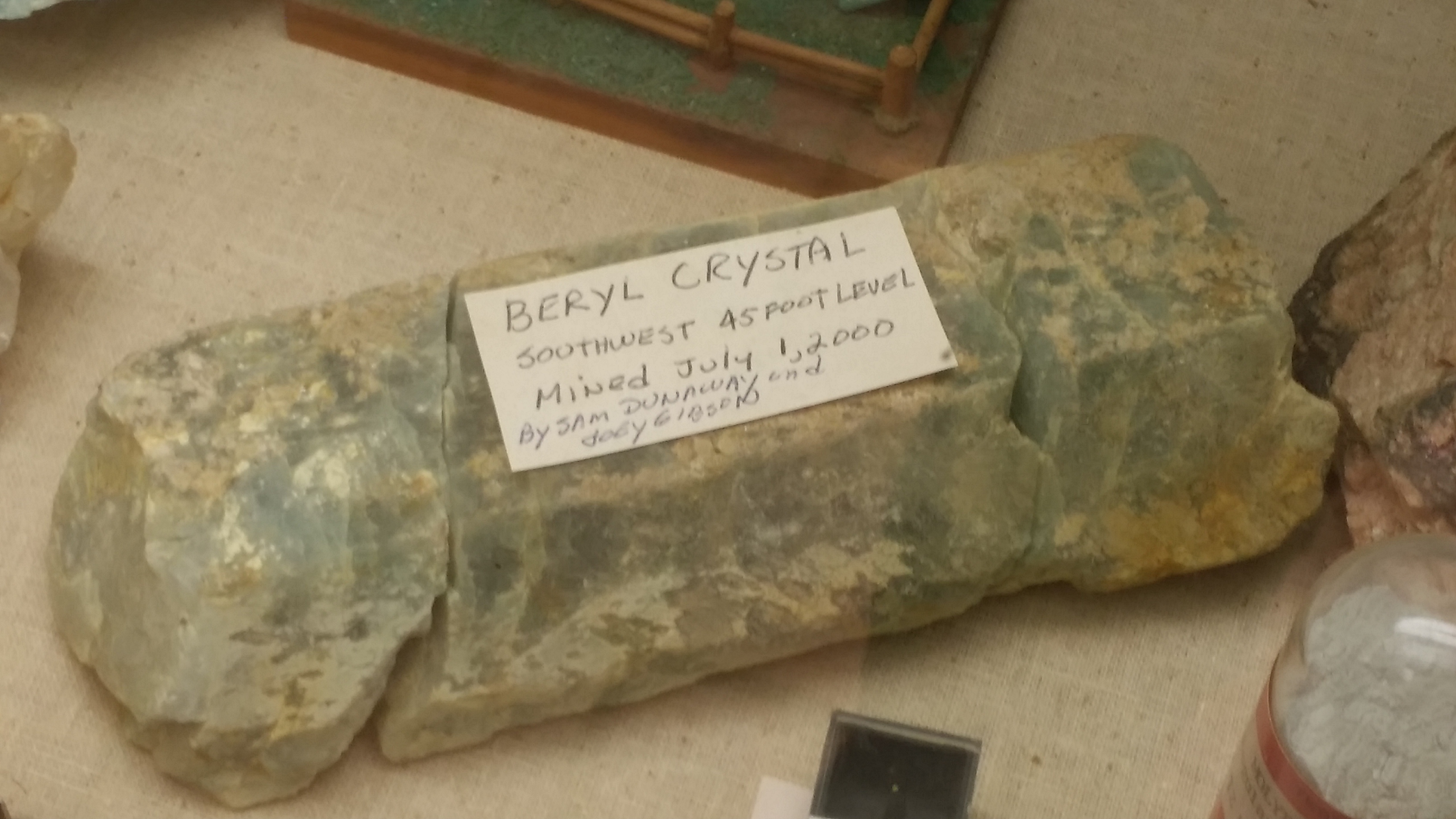
2002
In May, 2002, Morefield Gem Mine, Inc. retained the NCSU Minerals Research Laboratory at Asheville , NC, to do a metallurgical test based on the USBM work. They limited their test to magnetics using a “PermRoll Separator and a Carpco magnetic separator. The tests were on a 600 pound “run-of-mine” sample and a quantity of sluice box concentrates. The run-of-mine sample had a calculated head grade of 0.06 percent Ta. This is equal to 1.2 pounds of tantalum per ton. An analysis of pure tantalite was not made, but using the USBM number for Ta2O5 in handpicked tantalite of 45.7 percent, this would equal 2.6 pounds of tantalite per ton in the test sample (Tantalum 2017).
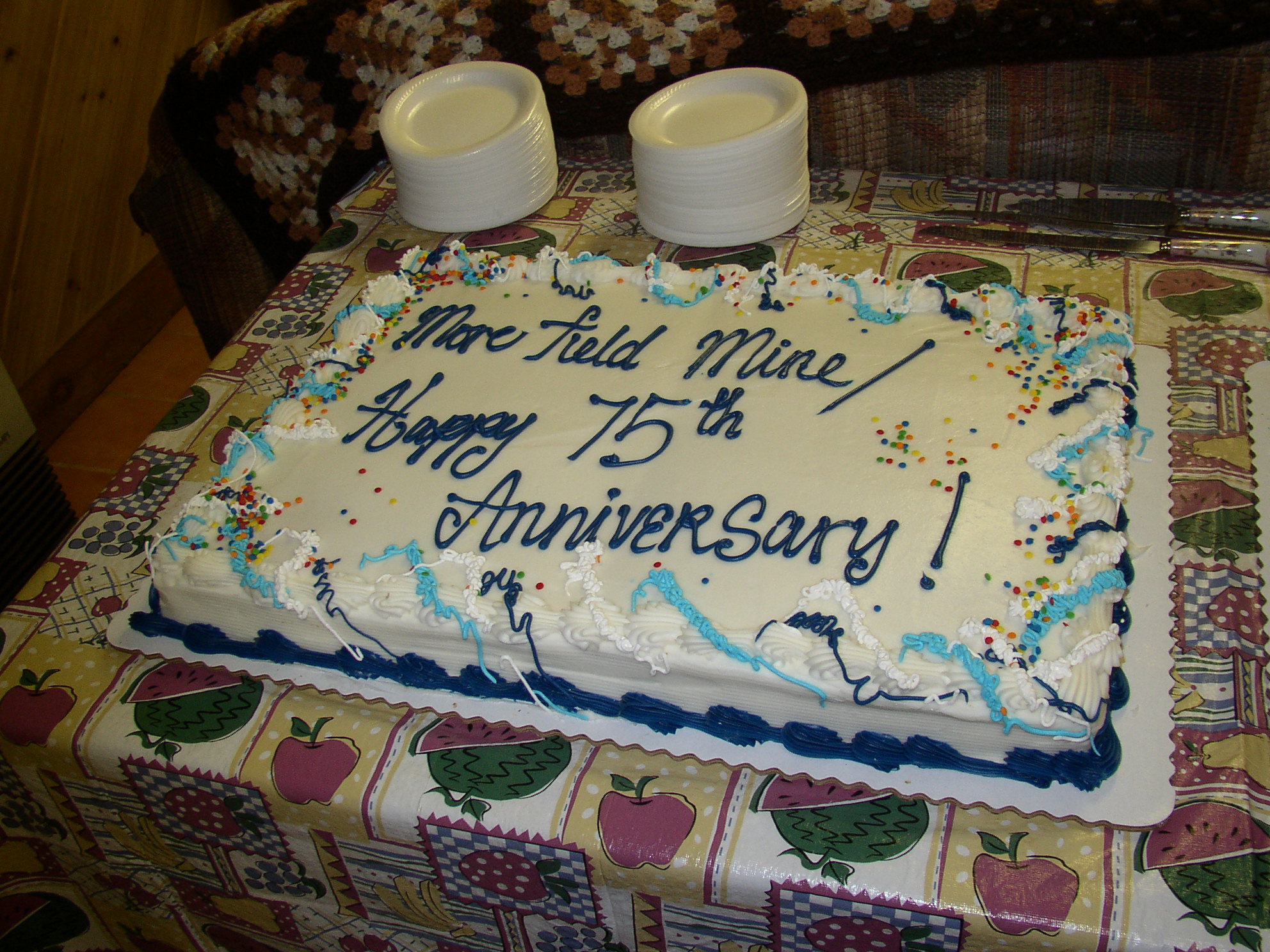 2004
2004
Morefield mine celebrated its 75th anniversary with a party at the mine, as well as the beautiful cake shown here. Photo courtesy of Betsy Martin. Used with permission.
2010
QVC™️ (Quality, Value, Convenience) included a Morefield Gem Mine-produced Amazonite enhancer on its television show.
2013
Martin Marietta is developing their quarry on our 65 acre tract adjoining the 15 acre Morefield mine tract. They've had a lease since 1989 on that tract and we were able to buy it in 2013.
2016
20160302_105344 Interview Sam and Sharon Dunaway
2017
Amelia County’s website states that, “Amelia is known for its minerals, including the nation's best supply of Amazonite found at the Morefield mine.”
In a personal email on 4/10/2017 Sam Dunaway noted, “Martin Marietta is developing their quarry on our 65 acre tract adjoining the 15 acre Morefield mine tract. They've had a lease
since 1989 on that tract. Welcome, Amelia County Virginia, Retrieved 4/11/2017, from http://www.ameliacova.com/.
https://dmme.virginia.gov/dmm/safety.shtml?platform=hootsuite
award
Figure 1 Comparing amazonite from Russia, Brazil and from the America (Morefield mine). Photo c 2016 Karen Smith-Will. All rights reserved.
February 22, 2017
The Morefield Gem Mine website displayed the following notice:
“The Morefield mine will be closed for the Spring and Summer of 2017 to the public and schools. We are still exploring deeper and further away from the present workings to better
understand the full size of the vein or dike. The amount of pegmatite to mine has increased over the 20 years of operation as we have better understood the deposit. Also, land adjacent to the Morefield Mine is being developed for a quarry site and there is much congestion due to heavy equipment moving in every direction including across the Morefield entrance. This does not impact future operation and expansion of the Morefield Mine and the mine site remains unchanged as Friends of Morefield Mine remember.”
April 15, 2017
Sam Dunaway and the author, Karen Smith-Will had a lengthy conversation about the current progress on the mine.
November 17, 2019
Morefield mine's 90th anniversary was held at the mine. Many guests who are important at the mine attended. One such guest was Karen Goodrich, who traveled to the mind from Maryland to attend. Morefield mine founder Silas Morefield was her great uncle.
November 2020
"It's been a 7 year on-and-off project to get into the 100' level and stay there! Three pumps, two tanks, independent floats controls, mud, 8 gpm coming down the shaft, but today by an act of God we succeeded! Mark (Wylie) and I explored it," per Sam Dunaway.
April 11, 2021
Sam & Sharon invited friends to Sam's 80th birthday party. One of his gifts was this interactive book.
May 23, 2021
An update from Sam Dunaway, mentioning a mysterious pegmatite on the 60' level, as well as the repair of the Norfolk and Western position light signal.
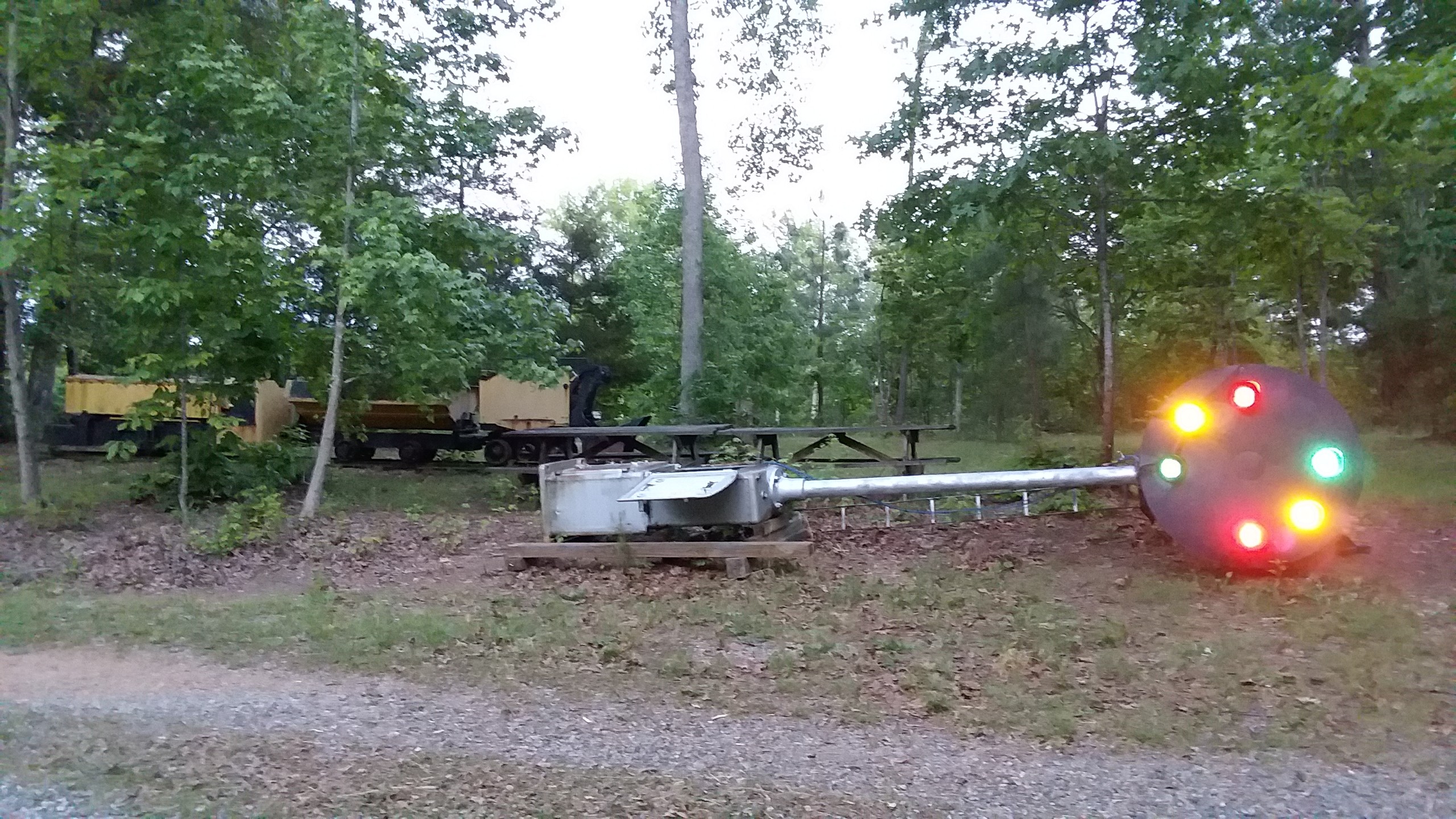
April 16, 2022
The Dunaways held a by-invitation-only event at the mine, to sell off some of the iconic above-ground pieces. In a surprising turn of events, they even had a significant pile of mine tailings--I wish I had brought a bucket!
The Lynchburg mineralogy club had a significant showing.
Near the end, I even had a chance to play some piano favorites, at Sam's request.
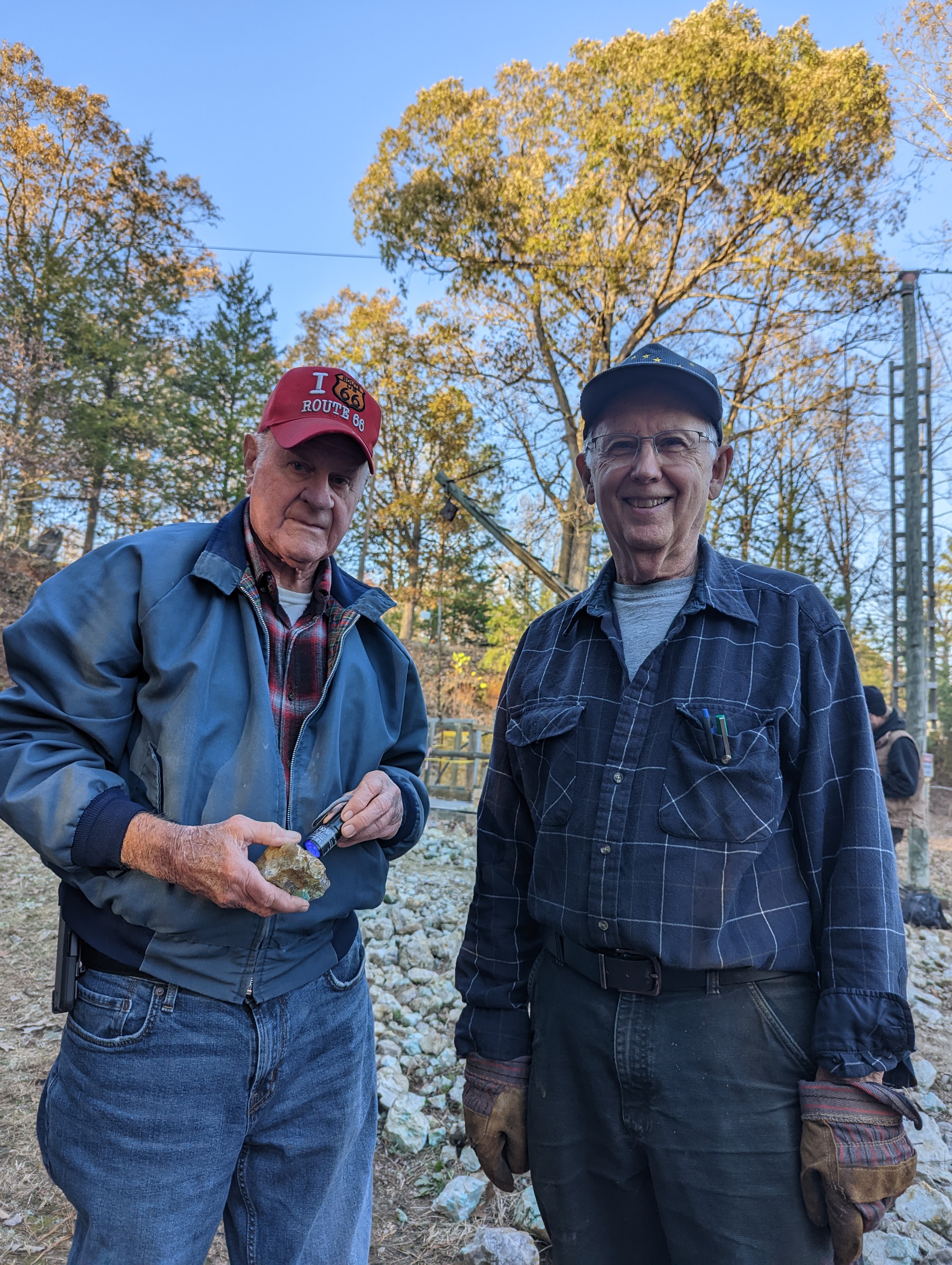
November 19, 2022
Morefield Gem Mine advertised this special event to the public via their Facebook page: They held their first open date in years, from 10a-4p. There was absolutely no digging allowed, while all of the mine tailings left from April were there for the taking. At a price, of course. ;)
For more of the store, link.
Photo above, Bernie and Sam
_____________
©️2021 to present ![]() Valutivity Press. All rights reserved.
Valutivity Press. All rights reserved.
